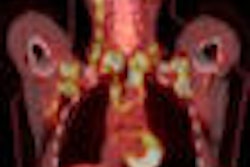
Advances in cancer detection and treatment have led to large improvements in survival rates. But with increased survival comes an increased need to minimize long-term treatment-related effects. In particular, children receiving radiation therapy are more susceptible to radiation carcinogenesis and have an increased risk of developing second cancers later in life.
Proton therapy offers a theoretical dosimetric advantage over photon radiotherapy, in terms of sparing of nearby tissues and organs. As such, it has been proposed as a promising modality for treating central nervous system cancers in pediatric patients. But while several studies have examined the stray radiation exposures associated with proton therapy, the risks from neutrons generated during such treatments have, in the main, been neglected.
With this in mind, researchers at M. D. Anderson Cancer Center at the University of Texas in Houston have compared the risks of developing a second cancer following craniospinal irradiation (CSI) delivered via four modalities: conventional photon therapy, intensity-modulated photon radiotherapy (IMRT), passively scattered proton therapy, and scanned-beam proton therapy, with neutron generation accounted for in the proton treatments (Physics in Medicine and Biology, April 2009, Vol. 54:8, pp. 2277-2291).
"To reduce unwanted radiation dose to healthy tissues, proton beams have been used to deliver CSI to children with medulloblastoma," explained Wayne Newhauser, from M. D. Anderson's department of radiation physics. "However, proton therapy also produces stray neutron radiation, which is approximately a factor of 10 more carcinogenic than photon radiation. Prior to our study, neutron exposures caused by proton CSI were not known."
Newhauser points out that this knowledge gap hinders evidence-based decisions on treatment-modality selection and healthcare policy. He also notes that previous publications speculating on the possible dangers of proton therapy have caused confusion as to the appropriateness of proton therapy for treating children, whereas in fact, evidence now shows that the risk is lower following proton therapy, regardless of whether the proton beams are produced with passive-scattering systems or magnetically scanned beams.
Risk assessment
The M. D. Anderson team simulated a pediatric medulloblastoma treatment based on CSI with a prescribed absorbed dose to the target volume of 36 Gy. Monte Carlo code was used to calculate the stray radiation doses from neutrons for passively scattered and scanned-beam proton treatments of a male phantom. The organ doses were then converted to risk of cancer incidence, using a standard formalism developed for radiation protection purposes.
This lifetime risk of developing a second cancer due to stray radiation was 1.5% for passively scattered proton therapy and 0.8% for the scanned-beam treatment. In both cases, the largest proportions of this risk were assumed by the skin (51% for passive scattering; 47% for scanned beams) and then the thyroid (10% and 17%, respectively).
The researchers next considered the added risk associated with exposure to the primary therapeutic proton beam (using dose values from the literature), and came up with an estimate for the total second cancer risk of proton therapy. They note that the risks associated with proton therapy are predominated by the primary radiation and not the stray neutron radiation.
These data were compared with the second cancer risks associated with conventional 6-MV photon radiotherapy and 6-MV IMRT. Results reveal that proton therapy offers substantially lower risk than photon therapy, even when neutrons are taken into account. The total predicted lifetime risks of developing a second cancer following IMRT and photon radiotherapy were 31% and 55%, respectively. These risk values are seven and 12 times higher than that of intensity-modulated proton therapy (4.4%), and six and 11 times higher than the second-cancer risk associated with passively scattered proton therapy (5.1%).
Using scanned beams as opposed to passive scattering only reduced the total second cancer risk by around 20%. "There is a misconception about passively scattered versus scanned-beam proton therapy, namely, that scanned-beam therapy was something of a silver bullet in this regard," Newhauser told medicalphysicsweb. "However, the evidence now shows that both systems are excellent and barely distinguishable in terms of their risks of second cancer following CSI."
Given the fact that fewer than 300 patients have been treated with scanned proton beams versus more than 40,000 with scattered proton beams, Newhauser notes that many of the recently claimed benefits of scanned-beam treatments seem overly optimistic and premature. In particular, the interplay of anatomical motion with a scanned beam can, in principle, lead to potentially significant errors in the delivered dose.
Reality check
In a separate study, Newhauser and colleagues examined the stray radiation dose and associated second cancer risk for a 10-year-old boy who received CSI using passively scattered protons. Here, the Monte Carlo calculations were based on simulation of a proton CSI treatment plan and whole-body kilovoltage CT images from an actual pediatric patient treated at M. D. Anderson (Phys Med Biol, April 2009, Vol. 54:8, pp. 2259-2275). "This represents an incremental increase in the realism of our risk assessments," Newhauser noted.
The proton-therapy plan created for the patient prescribed CSI at 30.6 Gy, plus a boost of 23.4 Gy to the clinical target volume. The effective dose from stray radiation for the entire treatment was calculated as 418 mSv -- roughly equivalent to the effective dose from 20 whole-body CT scans. The stray radiation comprised 82% from external neutrons (originating in the treatment unit) and 19% from neutrons originating within the patient.
The researchers estimated the corresponding excess lifetime risk of second cancer fatality from stray radiation for pediatric male patients who receive this treatment at 3.4%. They note that while this risk is small compared with the benefits of the radiotherapy, it is not negligible. As such, it is important to continue attempts to reduce stray radiation exposure as much as possible. For example, moving the snout away from the patient distances them from the field-defining collimator, which is the primary source of external neutrons.
Ultimately, the M. D. Anderson team aims to generate a high-quality body of evidence to support clinical decision-making as to whether a patient receives proton or photon therapy.
"In late 2008 we received a three-year research grant from the National Cancer Institute to support in silico clinical trials comparing the risk of late effects following proton therapy versus photon therapy," said Newhauser. "We expect that this will provide vital evidence to help evaluate the potential role of proton therapy in radiation oncology for children and young adults. One of our major long-term goals is to utilize findings from the in silico trials to guide the design of prospective randomized clinical trials."
By Tami Freeman
Medicalphysicsweb science editor
May 8, 2009
Related Reading
Proton therapy reduces bone marrow toxicity compared with IMRT, November 24, 2008
Proton therapy shows promise in treating chondrosarcoma, September 29, 2008
Proton therapy lowers chance of second malignancy, September 23, 2008
Michigan healthcare systems form proton beam partnership, June 3, 2008
Proton beam therapy effective in controlling hepatic tumors, August 17, 2006
© IOP Publishing Limited. Republished with permission from medicalphysicsweb, a community Web site covering fundamental research and emerging technologies in medical imaging and radiation therapy.




















